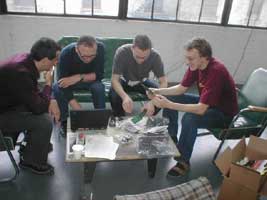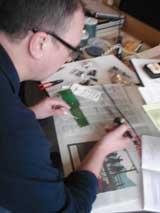
Welcome to fm.thing.net
THE THING in collaboration with r a d i o q u a l i a, and Jan Gerber started on May 5 2002 to build a radio network in NYC using internet audio (via wireless and wired connections) and miniFM. Initially the network will consist of 2-5 transmitters based around New York. Each of these transmitters will be less than 1W output and will source their audio live from the internet using the Frequency Clock scheduling system. This partly adopts the ethic of microradio as founded by Tetsuo Kogawa where many low powered FM transmitters are coupled to create an effective broadcasting entity that 'falls beneath the radar' of the communication authorities. fm.thing.net combines this ethic with that of net.radio which is a relatively new phenomenon focusing on the use of the internet as a carrier signal and is best illustrated by the practices of the Xchange network. By combining the net.radio and microradio we hope to build an efficient radio network in New York that uses the internet as a primary carrier of the audio for re-broadcasting on legal or almost legal microFM broadcasts.
(0)
|
(0)--net--(0)
|
(0)
We also hope to hang other transmitters off the 'core' transmitters, making a daisy-chain of transmitters. This would work by placing receivers coupled to transmitters so the signal gets picked up by the reciever and re-transmitted by the transmitter attached to it. Tetsuo Kogawa has a nice picture of how this looks on his microradio site:
http://anarchy.k2.tku.ac.jp/radio/micro/index.html
In addition to building and placing these transmitters the project is intended as research, and documentation will be created in the
following areas:
1. What is the legality in the USA of this type of network?
2. How is it possible to build a transmitter?
3. How can internet audio and miniFM effectively work together to create an effective audio distribution mechanism?
What is the legality in the USA of this type of network?
Well, in the US the airwaves are regulated by the Federal Communications Commission (FCC). The FCC website (http://www.fcc.gov)
specifically states
"Unlicensed Operation Prohibited." and continues with :
"A very common question asked to the FCC is whether broadcasting at very low power requires a license.
Please be aware that unlicensed operation of radio broadcast stations is
prohibited, even at such low powers such as 1 watt or less. The only unlicensed operation that is permitted on the AM and FM broadcast
bands is covered under Part 15 of the FCC's rules, and is limited to a coverage radius of approximately 200 feet. (See the
Commission's July 24, 1991 Public Notice.) Unlicensed operation is also not permitted in the television bands (including 87.9 MHz, which
falls within the 82.0 to 88.0 Channel 6 television band). Fines and/or criminal prosecution may result from illegal operation of an
unlicensed station."
http://www.fcc.gov/fcc-bin/audio/howtoapply.html
However when we rang the FCC the representative of the Radio Frequencies division said anything under 1W is ok....confused?
If you dig a little deeper its easy to find the following document which clearly states that any FM broadcast under 0.01 microwatts (a
radiated diameter of 200 feet) is ok.
http://www.fcc.gov/mb/audio/decdoc/scandoc/910724/1.jpg
Sound ok? Well just be a bit careful...in an email we received from the FCC, they state :
"Presently, the maximum penalty for operating an unlicensed or "pirate"
broadcast station (one which is not permitted under Part 15 or is not a
Carrier Current Station) is set at $10,000 for a single violation or a single
day of operation, up to a total maximum amount of $75,000."
There is another section of the FCC which looks at licensed broadcasts with FM for lower power (1W-100W). More information can be found
here:
http://www.fcc.gov/mmb/prd/lpfm/
If you do go ahead with transmitting unlicensed then you should prepare incae the FCC do knock on your door. Some information about what
to do can be found at:
http://www.freeradio.org/legal/legal.html
o
And if you really want to study some case histories, then check out the site of the Center for Democratic Communications
(http://www.nlgcdc.org/)
How is it possible to build a transmitter?
We initially started with a transmitter that was half built by Walter and Jan turned a capacitor upside down, and it worked...what did
we learn? We learnt that none of us knows anything about electronics ;-)
[x]


http://www.ramseyelectronics.com/cgi-bin/commerce.exe?preadd=action&key=FM100
Looking at the nice picture of the transmitter is the easy bit...making it is the hard bit. Wolfgang [x]



So on this day we have 2 working transmitters which is the basis for the start of the network. Next we need to plan a machine dedicated to receiving the content from the net, and how we will launch fm.thing.net
In addition, as Tetsuo Kogawas work is central to this idea, we really want to make the network 'viral' - in the sense that anyone should be able to build a transmitter and hang it onto the same network. So, we have discussed this with Tetsuo in Japan and he couried us all the parts for making a 1W transmitter from the very basics. We then had a workshop with Tetsuo streaming from Japan and we built the transmitter according to his guidelines. If you want to build your own transmitter like this then please have a look at this page to see how its done or you can watch the workshop that Tetsuo gave (RealVideo).
How can internet audio and miniFM effectively work together to create an effective audio distribution mechanism?
So, once we had the transmitters built we moved on to getting the streams set up. This bit was also tricky because we had to use some older machines that didn't have much 'grunt'. We managed to get our hands on an old 333mhz Pentium II machine with 32MB memory. In addition it had an ethernet card and a soundcard. So we installed Windows 98 (yeeesh) on it and download the following softwares:
Winamp (http://www.winamp.com)
RealPlayer 8 (http://www.real.com)
Frequency Clock (http://www.klari.net/radioqualia)
Shoutcast DSP (http://www.shoutcast.com)
Virtual Audio Cable (http://spider.nstu.nsk.su/music/software/eng/vac.html)
We used the Winamp and Shoutcast plugin to stream to Things Icecast Server. At the moment we are using this plugin as it streams MP3 very efficently. We wanted to use the Oddsock plug in so we could stream the unpatented Ogg Vorbis audio codec, but we found it was very inefficient when encoding directly from a line-in.
The Frequency Clock is a stream scheduling software created by r a d i o q u a l i a. Sources for the Frequency Clock can also be downloaded at Source Forge (http://openfc.sourceforge.net).
The Frequency Clock is used for creating a schedule of the program from files on the local drive of the encoding machine, and from streams from the net. The Winamp/Shoutcast software (which is on the same machine) then re-encodes this as a single MP3 stream. We used the Virtual Audio cable as it allows us to feed the audio out (Frequency Clock Player) into the audio in (winamp) without using analog cables...it does it 'virtually'....
Then the encoded stream goes to the Icecast server at Thing and you can listen to it if you use a MP3 compatable media player and enter this url : http://audio.thing.net:8000
This stream is then picked up by machines that are connected to the net around NYC, as much as possible we want to use the free wireless nodes (802.11b) that are located around the city, and the audio-out of these computers feeds into the audio-in of the transmitters...
(0)
More Information
General
Free Radio Berkeley
How to be a Radio Pirate
Polimorphous Space
Prometheus
Freespeech.org
How to Build Transmitters
Ramsey Electronics
Veronica
How to Solder
|
(0)--fm.thing.net--(0)
|
(0)
There is of course a long history of microradio in the USA. The following sites provide excellent resources:
radio4all
http://www.radio4all.org
An excellent site covering the basics of microradio inclusing a great section on how to set up a station
(http://www.radio4all.org/how-to.html)
Probably the most famous US case, and an excellent site for microradio info, especially if you want to know the US legal issues.
http://www.freeradio.org/
An irational.org site full of great basic information.
http://www.irational.org/sic/radio/
Tetsuo Kogawas site, full of great information including how to make your own FM transmitter from the most basic beginnings.
http://anarchy.k2.tku.ac.jp/
A very informative site about community radio. They have a good section on pirate radio too
(http://www.prometheusradio.org/alt_pirate.shtml)
A good section on the basics of low powered transmitting.
http://free.freespeech.org/lowpower/guide.html
Free Radio Berkeley
FRB sell transmitters.
http://www.freeradio.org/store/frb_kits.html
Some good kits.
http://www.ramseyelectronics.com/
Based in the UK
http://www.veronica.co.uk/
http://www.irational.org/sic/radio/solder.html